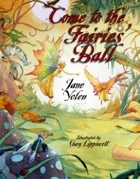
Come to the Fairies’ Ball
Illustrated by Gary Lippincott
Wordsong/Boyds Mills Press 2009
ISBN: 1-59078-464-2
ISBN-13: 978-1-59078-464-8
This book began in a very different way from most of my books. My dear friend Gary Lippincott, an illustrator I have known for years and whose career I have had a bit of a hand in. His first book sale was for the cover of my anthology Werewolves, at my request of the editor; and when I had my own imprint at Harcourt, I used Gary for several books, most notably the Bruce Coville Magic Shoppe books, and Peggy Christian’s The Bookstore Mouse. He showed me a glorious painting of the full ball scene and a pretty complete dummy, of The Fairies’ Ball, but his writing (even he concurred) was awful and there was no real story. I said, “I’ll write it!” and I did. We didn’t sell it to the first editor who saw it, but it ended up with the right editor, as so often happens. I take each rejection as an opportunity!
Accolades:
- Both Come to the Fairie’s Ball and My Uncle Emily were chosen for the year’s best books by the Bank Street College of Education, saying: ” Come to the Fairies’ Ball: A joyful rhyming story tells of a fairies’ ball. Amusing, imaginative illustrations. My Uncle Emily: This moving picture book with expressive period-style illustrations explores the relationship between Emily Dickinson and her nephew, Gib. Biographical information.”
What reviewers have said:
- “Jane Yolen is a dream come true for a children’s librarian — she writes superbly well for all ages. This book is every bit as wonderful. In fact, I read this book out loud to my young son, who is a huge fan of her “How Do Dinosaur…” books, and he sat enrapt through the entire tale. The story itself is a bit “Psyche”, a bit “Cinderella”, a bit Christina Rossetti and all charm and pure magic. It is as delightful as any classic fairy tale, with a markedly modern twist. Gary Lippincott does an amazing job keeping up with, and illuminating, Jane Yolen’s marvelous story. Every illustration is breathtakingly beautiful, and like the writing, all charm and pure magic. My favorite illustration is the two-page spread of the ballroom — I could get lost in there and never want to return to the real world.”–Books I Buy and Why blog
- “. . .told with a stately tone and compelling melody. . Accompanying the poem’s quiet music like a fairy harp, Dyer’s vibrant and magical watercolors alternate between scenes of translucent twilight and golden eart.h . .this book’s enchanting spell.”—Publisher’s Weekly
- “A well-developed rhyming text. . .delicate, detailed watercolors emphasize the ethereal nature of the fairy world and the vibrant life of nature above.”—Horn Book Guide
- “I feel I have to tell you right Catalogue up front—I am so in love with this book, I want every child and every family to own a copy.”—Chinaberry Catalogue
- “This rhyming Cinderella-type story will draw you into the magical world of the fairies with its stunning illustrations!” —KidsBookShelf.com
- A sweet story with plenty of verve and humor, fairy fans will be delighted with this gorgeously illustrated story of a fairy ball.”–Jean Little Library on Blogspot
- “I fell in love with this book the moment I opened it! Words that have such rhythm that they sing-out to be voiced aloud! Such pictures – pictures that you want to spend hours devouring, pictures by Gary Lippincott that have the most wonderful surprises and fun as you delve into them!”– http://muletownyouthlibrarian.blogspot.com
- “Loosely inspired by the Cinderella story, Come to the Fairies’ Ball plays with familiar fairy tale conventions by allowing the Cinderella character to become her own fairy godmother. Yet this picture book’s real appeal lies not in the plot but in the sheer spectacle provided by Jane Yolen’s fast-paced rhyming narrative and fantasy artist Gary Lippincott’s fairy pictures. . . Each full color page contains a treasure trove of fantasy art as readers get to enjoy glimpses into a fairy’s home, palace, and even transport system (the pages showing the fairies traveling on turtles, dragonflies, snails, and fish are particularly enchanting). A great fairy picture book to read to grade school children, Come to the Fairies’ Ball also makes a great gift for lovers of fantasy art and pictures of fairies.”– Suite101
- “Come to the Fairies’ Ball uses amazing onomatopoetic vocabulary and still manages to rhyme! This is one of the most interesting rhyming stories I have ever read because of the alliterative and creative words that Yolen uses to describe the action. The author also sets the fairy kingdom in reality, but does not forget the magic. Fairies ride to the ball on rabbits, turtles, and butterflies, but readers still sense a bit of magic (and maybe even a little love) in the air. In keeping in the tradition of fairy tales the book is gently laced with lessons about punctuality, friendship, hard work, helping others, and true love.
As for the illustration, I like that Lippincott eschews the Disney version of fairies and uses earthy tones of browns, greens, pale yellows, and oranges. Even inside the glowing hall where the ball takes place, the colors remain earthy. The fairies themselves are not the usual fairies either. Lippincott portrays the inhabitants of the kingdom as angular and as varied in looks as any group of humans might be. . . . In all this story is a fast, fun, rhyming love story that leaves readers believing (in fairies, love, fun, and friendship).” —Booking it.